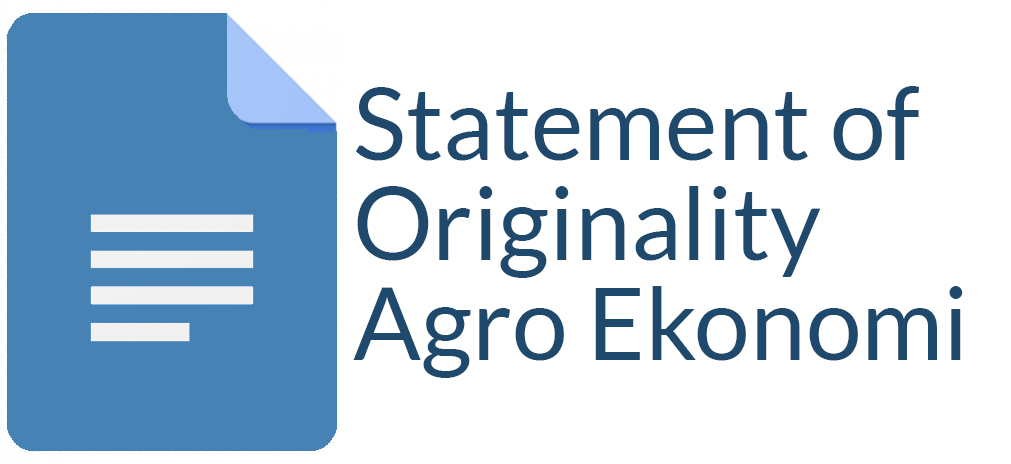Feasibility and Risks of Chili Farming in Disaster-Prone Areas of Mount Merapi, Indonesia
Nur Rahmawati(1*), Zuhud Rozaki(2), Rofiqoh Zuroida Al Riyadh(3), Susanawati Susanawati(4)
(1) Department of Agribusiness, Faculty of Agriculture, Universitas Muhammadiyah Yogyakarta
(2) Department of Agribusiness, Faculty of Agriculture, Universitas Muhammadiyah Yogyakarta
(3) Department of Agribusiness, Faculty of Agriculture, Universitas Muhammadiyah Yogyakarta
(4) Department of Agribusiness, Faculty of Agriculture, Universitas Muhammadiyah Yogyakarta
(*) Corresponding Author
Abstract
Mount Merapi, located in Indonesia, is an active volcano that poses a significant threat to the surrounding communities. Vegetables, including chili, are grown in the disaster-prone areas surrounding Mount Merapi, despite the risks associated with the active volcano. Based on the prevailing wind patterns in the region, the disaster-prone areas surrounding Mount Merapi have been classified into four distinct zones, namely Zones I, II, III, and IV, each characterized by distinct agroecosystems, feasibility, and risk levels. Therefore, this study aimed to describe agroecosystems, costs, income, feasibility, and risks of chili farming in in the four zones surrounding Mount Merapi. The samples of this study consist of 163 farmers from the four disaster-prone zones surrounding Mount Merapi, selected through purposive sampling. The RC ratio was employed as part of the feasibility analysis, and the production and income risks were analyzed. The results showed that chili farming in Zone IV (the area farthest from the disaster center) possessed the lowest cost, revenue, and income. On the contrary, Zone III generated the highest cost and revenue, while Zone I (the area with the highest vulnerability to disasters) had the highest income. The range of R/C values ranges from 2.40 in Zone I to 1.16 in Zone IV. Considering the results, chili farming was feasible in disaster-prone areas, where the production risk was lower than the income risk. Therefore, Zone I, the area with extremely high disaster risk, had the lowest production and income risk. This study highlighted that chili farming provides benefits to the vulnerable farmers and new perspective for agricultural sustainability in the area of Mount Merapi.
Keywords
Full Text:
PDFReferences
Adekaldu, E., Amponsah, W., Tuffour, H. O., Adu, M. O., & Agyare, W. A. (2021). Response of chilli pepper to different irrigation schedules and mulching technologies in semi-arid environments. Journal of Agriculture and Food Research, 6, 100222. https://doi.org/10.1016/J.JAFR.2021.100222
Aini, L. N., Soenarminto, B. H., Hanudin, E., & Sartohadi, J. (2019). Plant nutritional potency of recent volcanic materials from the southern flank of mt. Merapi, Indonesia. Bulgarian Journal of Agricultural Science, 25(3), 527–533.
Antriyandarti, E., Ferichani, M., & Ani, S. W. (2013). Sustainability of Post-Eruption Socio Economic Recovery for the Community on Mount Merapi Slope through Horticulture Agribusiness Region Development (Case Study in Boyolali District). Procedia Environmental Sciences, 17, 46–52. https://doi.org/10.1016/j.proenv.2013.02.010
Ardhona, S., Hendarto, K., Karyanto, A., & Ginting, Y. C. (2013). Pengaruh Pemberian Dua Jenis Mulsa dan Tanpa Mulsa Terhadap Karakteristik Pertumbuhan dan Produksi Tanaman Cabai Merah (Capsicum annum L.). J. Agrotek Tropika, 1(2), 153–158.
Bharati, S., Joshi, B., Dhakal, R., Paneru, S., Dhakal, S. C., & Joshi, K. R. (2020). Effect of Different Mulching on Yield and Yield Attributes of Potato in Dadeldhura District, Nepal. Malaysian Journal of Sustainable Agriculture, 4(2), 54–58. https://doi.org/10.26480/mjsa.02.2020.54.58
Brata, A. G., Rietveld, P., de Groot, H. L. F., Resosudarmo, B. P., & Zant, W. (2014). Living with the Merapi Volcano: Risks and Disaster Microinsurance.
Burleigh, J. R., Vingnanakulasingham, V., Lalith, W. R. B., & Gonapinuwala, S. (1998). Pattern of pesticide use and pesticide efficacy among chili growers in the dry zone of NE Sri Lanka (System B): Perception vs reality. Agriculture, Ecosystems and Environment, 70(1), 49–60. https://doi.org/10.1016/S0167-8809(97)00159-X
Challender, D. W. S., ’t Sas-Rolfes, M., Ades, G. W. J., Chin, J. S. C., Ching-Min Sun, N., Chong, J. lian, Connelly, E., Hywood, L., Luz, S., Mohapatra, R. K., de Ornellas, P., Parker, K., Pietersen, D. W., Roberton, S. I., Semiadi, G., Shaw, D., Shepherd, C. R., Thomson, P., Wang, Y., … Nash, H. C. (2019). Evaluating the feasibility of pangolin farming and its potential conservation impact. Global Ecology and Conservation, 20, e00714. https://doi.org/10.1016/j.gecco.2019.e00714
Döring, T. F., & Reckling, M. (2018). Detecting global trends of cereal yield stability by adjusting the coefficient of variation. European Journal of Agronomy, 99(November 2017), 30–36. https://doi.org/10.1016/j.eja.2018.06.007
Duhan, A. (2018). Vegetable Crops: Risks and Losses Faced by Farmers. Advances in Research, 12(6), 1–8. https://doi.org/10.9734/air/2017/38786
Dwi Nugroho, A., Yoga Prasada, I. M., Kirana, S., Anggrasari, H., & Nawang Sari, P. (2018). Komparasi Usahatani Cabai Lahan Sawah Lereng Gunung Merapi dengan Lahan Pasir Pantai. AGRARIS: Journal of Agribusiness and Rural Development Research, 4(1). https://doi.org/10.18196/agr.4156
Eliyatiningsih, & Mayasari, F. (2019). Efisiensi Penggunaan Faktor Produksi pada Usahatani Cabai Merah di Kecamatan Wuluhan Kabupaten Jember. Jurnal Agrica, 12(1), 7. https://doi.org/10.31289/agrica.v12i1.2192
Emran, S., & Shilpi, F. (2018). Agricultural productivity, hired labor, wages, and poverty: Evidence from Bangladesh. World Development.
Fiantis, D., Ginting, F. I., Gusnidar, Nelson, M., & Minasny, B. (2019). Volcanic Ash, insecurity for the people but securing fertile soil for the future. Sustainability (Switzerland), 11(11). https://doi.org/10.3390/su11113072
Gobie, W. (2017). Cogent Food & Agriculture A seminar review on red pepper (Capsicum) production and marketing in Ethiopia Wubalem Gobie | A seminar review on red pepper (Capsicum) production and marketing in Ethiopia. Cogent Food & Agriculture, 1304. https://doi.org/10.1080/23311932.2019.1647593
Handayani, D., Sopha, B. M., Hartono, B., & Herliansyah, M. K. (2019). Behavior Proportion According to Merapi Volcano Eruption Evacuations in 2010. Proceedings of the 2018 International Conference on Industrial Enterprise and System Engineering (IcoIESE 2018), 2(IcoIESE 2018), 177–182. https://doi.org/10.2991/icoiese-18.2019.32
Indrasti, R., Rawung, J. B. M., Sudolar, N. R., Andri, K. B., Sahram, & Tan, S. S. (2021). Farmer institutional and economic feasibility study on red chilli pepper farming in Kepung District, Kediri Regency, East Java Province. IOP Conference Series: Earth and Environmental Science, 807(2). https://doi.org/10.1088/1755-1315/807/2/022018
Kaburuan, E. R., Jayadi, R., & Harisno. (2019). A design of IoT-based monitoring system for intelligence indoor micro-climate horticulture farming in Indonesia. Procedia Computer Science, 157, 459–464. https://doi.org/10.1016/j.procs.2019.09.001
Kapoor, R., Kumar, A., Sandal, S. K., Sharma, A., Raina, R., & Thakur, K. S. (2022). Water and Nutrient Economy in Vegetable Crops through Drip Fertigation and Mulching Techniques: A Review. Journal of Plant Nutrition, lates Arti. https://doi.org/https://doi.org/10.1080/01904167.2022.2063742
Laishram, C., Vashishat, R. K., Sharma, S., Rajkumari, B., Mishra, N., Barwal, P., Vaidya, M. K., Sharma, R., Chandel, R. S., Chandel, A., Gupta, R. K., & Sharma, N. (2022). Impact of Natural Farming Cropping System on Rural Households—Evidence From Solan District of Himachal Pradesh, India. Frontiers in Sustainable Food Systems, 6(May). https://doi.org/10.3389/fsufs.2022.878015
Muir, J. A., Cope, M. R., Angeningsih, L. R., Jackson, J. E., & Brown, R. B. (2019). Migration and mental health in the aftermath of disaster: Evidence from Mt. Merapi, Indonesia. International Journal of Environmental Research and Public Health, 16(15), 1–29. https://doi.org/10.3390/ijerph16152726
Napisah, Gunawan, B., Abdoelllah, O. S., & Sulaeman, M. (2017). Economic Rationality of Residents Living in the Area Prone to Merapi Volcanic Disaster. Komunitas: International Jornal of Indonesian Society and Culture, 9(2), 203–215. https://doi.org/10.15294/komunitas.v9i2.10002
Rahayu, H. S., Muchtar, M., & Saidah, S. (2019). The feasibility and farmer perception of true shallot seed technology in Sigi District, Central Sulawesi, Indonesia. Asian Journal of Agriculture, 3(01), 16–21. https://doi.org/10.13057/asianjagric/g03103
Release, P. (2020). Peningkatan Status Aktivitas G. Merapi Dari “WASPADA ke SIAGA.” Https://Magma.Esdm.Go.Id/v1/Press-Release/201/Peningkatan-Status-Aktivitas-g-Merapi-Dari-Waspada-Ke-Siaga.
Rozaki, Z., Rahmawati, N., Wijaya, O., Mubarok, A. F., Senge, M., & Kamarudin, M. F. (2021). A case study of agroforestry practices and challenges in Mt . Merapi risk and hazard prone area of Indonesia. Biodiversitas, 22(6), 2511–2518. https://doi.org/10.13057/biodiv/d220661
Sukmana, O. (2018). Pengetahuan Manajemen Bencana dan Kearifan Sosial di Kabupaten Malang. Sosio Konsepsia, 7(03), 190–204.
Tampubolon, J., Nainggolan, H. L., Ginting, A., & ... (2018). Mount Sinabung Eruption: Impact on Local Economy and Smallholder Farming in KaroRegency, North Sumatra. … Series: Earth and …. https://doi.org/10.1088/1755-1315/178/1/012039
Thompson, M. A., Lindsay, J. M., Wilson, T. M., Biass, S., & ... (2017). Quantifying risk to agriculture from volcanic ashfall: a case study from the Bay of Plenty, New Zealand. Natural Hazards. https://doi.org/10.1007/s11069-016-2672-7
Widyastuti, D. E., Ibrahim, J. T., Winaya, A., & Sukorini, H. (2019). Financial Feasibility Analysis of Red Chili Pepper Seedling at Karanganyar, Poncokusumo, Malang. Insist, 4(1), 188–190. https://doi.org/10.23960/ins.v4i1.188
Zul Mazwan, M., Tarik Ibrahim, J., & A M Fadlan, W. (2020). Risk Analysis of Shallot Farming in Malang Regency, Indonesia. Agricultural Social Economic Journal, 20(3), 201–206. https://doi.org/10.21776/ub.agrise.2020.020.3.3
Article Metrics
Refbacks
- There are currently no refbacks.
Copyright (c) 2023 Agro Ekonomi

This work is licensed under a Creative Commons Attribution-ShareAlike 4.0 International License.
View My Stats











